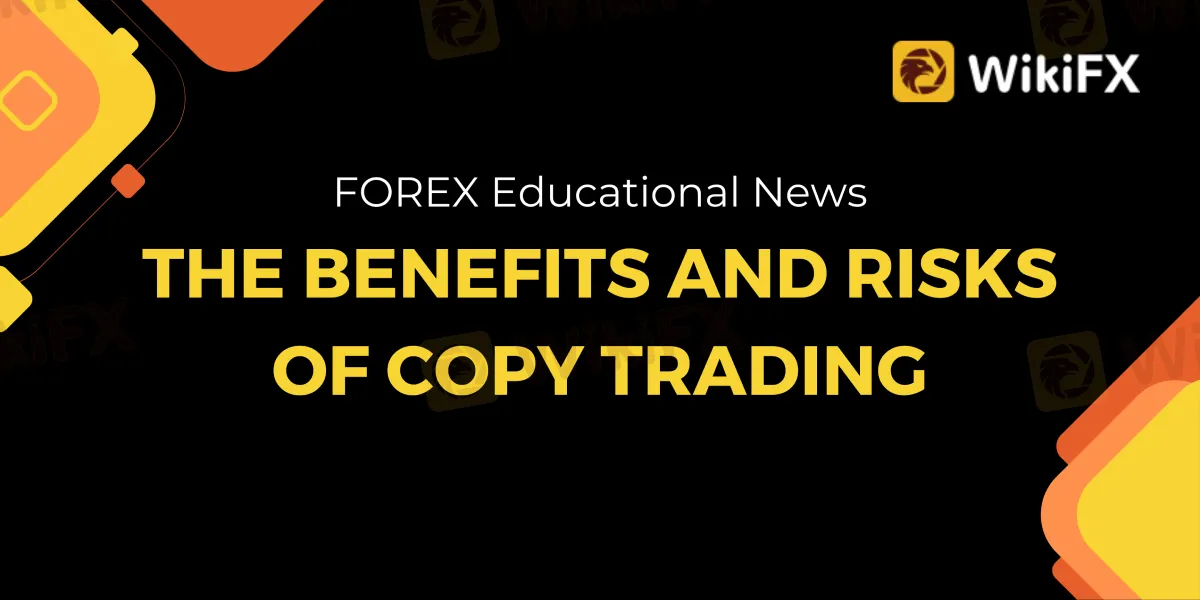简体中文
繁體中文
English
Pусский
日本語
ภาษาไทย
Tiếng Việt
Bahasa Indonesia
Español
हिन्दी
Filippiiniläinen
Français
Deutsch
Português
Türkçe
한국어
العربية
The Benefits and Risks Of Copy Trading
Abstract:Traders can use copy trading to make the same moves in the financial markets as other investors. There are various methods for copying another investor's trades. A trader, for example, might duplicate all transactions, including trade-entry, take-profit, and stop-loss orders. They might also get trade alerts and manually duplicate these transactions.

The purpose of copy trading is for the trader to be in the same position as the investor. When you blindly copy another trader's deals, you don't get a sense of how that trader works. This is different from mirror trading, which lets you use the same strategies as a real trader.
Mirror trading gave birth to copy trading in 2005. Initially, traders would copy certain algorithms produced via automated trading. Developers made their trade history public, enabling others to replicate their tactics. This circumstance resulted in the formation of a social trade network. Eventually, rather than replicating a method, dealers started to imitate deals made by other traders in their own trading accounts.
What advantages does copy trading have?
Portfolio management includes copy trading. The idea is to locate other investors whose track record you want to replicate. “Copy trading” is a method that traders can use to copy the strategies of other successful traders. Before putting real money at risk, investors should watch the investor. This is true of any trading strategy a trader chooses to use.
Copy trading might be beneficial for traders who do not have the time to monitor the markets. Copy trading is mostly focused on short-term trading. However, there are various alternative tactics utilized to make money. Most of the assets used have to do with the foreign exchange market and contracts for differences. While copy trading may be profitable, there are dangers involved, and traders should keep in mind that previous successes do not guarantee future profits.
ADDING DIVERSITY TO YOUR PORTFOLIO
Traders may diversify their portfolios by using copy trading. This indicates that a trader employs various strategies to profit in the markets. Traders might use different methods instead of putting all of their eggs in one basket. When copy trading, you should think about copying a few different traders.
Finding duplicate traders who trade multiple financial products is one method to diversify. For example, a forex trader and a commodities trader might both be copied. They might also think about following traders who employ various time periods. One may be an intraday trader, while the other may be a longer-term trader. Traders with high volatility in their returns vs those with low volatility in their returns might also be evaluated. Finally, evaluate extremely active traders vs less active traders. However, keep in mind that if anything looks to be too good to be true, it most often is.
The business strategy utilized in copy trading has the potential to be profitable. The majority of copy-trading enterprises are subscription-based, with individuals paying a monthly fee to copy traders. Revenue sharing is an alternate approach that may be implemented. A fixed proportion of successful deals is awarded here.
What are the disadvantages of copy trading?
When copy trading, the largest risk a trader faces is market risk. If a trader's approach is ineffective, they may lose money. When markets are unstable and it's hard to buy or sell the instruments they trade, this is called liquidity risk. Traders may also suffer systematic losses if the price of the product they are trading rapidly rises or falls.
Market danger
The risk of loss owing to fluctuations in the price of a security is referred to as “market risk.” The idea is to profit when the value of the traded item rises. There is obviously a danger that the item may lose value.
Traders may protect themselves against the market risk that is more than what they anticipate losing by using an asset allocation strategy. This implies that a certain plan receives just a limited quantity of funding. If a trader invests all of their money in a single trading method, they risk losing a lot if something unexpected occurs, wiping away their whole capital.
Traders may diversify their portfolios by investing in several techniques. A diversification approach may assist traders in making money in a variety of market circumstances. Many tactics depend on market trends. Individuals who choose just traders who perform well at these times may end up losing money in sideways trading market circumstances.
Risk of liquidity
Liquidity risk implies that holdings may not be exited at predicted levels. Risk management for a strategy should have been used before so that the trader can see what the copied trader's biggest loss was in the past. The greatest drawdown depicts the strategy's peak-to-trough fall during its lifetime. This is an important metric because it tells traders how much they can afford to lose at any given time if they use the strategy. A day trader, for example, may have a maximum drawdown of 20%. This indicates that if you start mimicking the trader, you should expect to lose at least 20% of your money.
Traders can also use it to find out more about the goods and asset classes they trade. This is due to the fact that each instrument has a varied amount of liquidity. For example, a trader will find it much easier to get out of a EUR/USD position than one in an emerging currency. If you wish to emulate traders that specialize in currencies from developing economies, you should look at how they account for slippage in their returns. During times of high volatility, slippage may be severe.
Systemic danger
Currency in emerging markets is more vulnerable to systemic threats. This implies that a trader's money might be locked up and they may be unable to exit their positions. This has occurred in the past when governments have been toppled and the capital has been sealed off and barred from leaving. Even though this is a very unlikely situation, it should be thought about when making a plan, especially for the foreign exchange market.
Last Words
Mimic trading is a method of portfolio management in which you copy the deals of another trader and monitor how well they perform. Copy trading may also be done mechanically, with the deals being made for the individual. Traders may perform their own transactions using a manual version. You have more options with the manual version, and if you use it, your returns will be different from those of the cloned trader in the past.
You should only provide each duplicate trader with a specific quantity of your cash. If a trader has set aside a separate capital pool for copy traders, they should diversify to avoid putting all of their money at risk with a single trader.
When copy trading, traders are exposed to a number of hazards. The most common kind of risk is market risk. Before putting money at risk, make sure you are okay with the maximum drawdown of the copied trader. This is the capital's peak-to-trough decrease, which may occur at any moment. This implies that, although a copy trader's previous returns may be good, if a person starts copying the trader while he is at his height, they may have a period of poor performance.
If you continue to hold your position after 5 p.m. New York time (10 p.m. UK time), your account will be debited or credited at the current holding rate. If you bought a currency with a higher yield, you may have gotten interested. If you bought a currency with a lower yield, you may have been charged interest.
Traders must also be cautious of systemic risk. This is where you mimic traders that speculate on developing market currencies since they risk having their money locked up.
Before starting copy trading, a trader may choose to set up a demo account and copy trades by hand to see if the returns are as good as promised.
Keep an eye out for more Forex news.
To stay up to date on the latest news, download the WikiFX App from the App Store or Google Play Store

Disclaimer:
The views in this article only represent the author's personal views, and do not constitute investment advice on this platform. This platform does not guarantee the accuracy, completeness and timeliness of the information in the article, and will not be liable for any loss caused by the use of or reliance on the information in the article.
Read more

Close Up With WikiFX —— Take A Close Look At Amillex
With the rapid growth of global multi-asset investment markets, the differences among regional forex markets have become increasingly significant. As a forex broker information service platform operating in more than 180 countries and regions, WikiFX is dedicated to helping investors in every market identify reliable brokers. Therefore, we have launched an exclusive interview series —— "Close Up With WikiFX", offering in-depth conversations with local brokers. This series aims to dive deep into frontline markets and provide first-hand information, helping investors gain a clearer and more comprehensive understanding of quality brokers.

Seacrest Markets Exposed: Are You Facing Payout Denials and Spread Issues with This Prop Firm?
Seacrest Markets has garnered wrath from traders owing to a variety of reasons, including payout denials for traders winning trading challenges, high slippage causing losses, the lack of response from the customer support official to address withdrawal issues, and more. Irritated by these trading inefficiencies, a lot of traders have given a negative review of Seacrest Markets prop firm. In this article, we have shared some of them. Take a look!

GKFX Review: Are Traders Facing Slippage and Account Freeze Issues?
Witnessing capital losses despite tall investment return assurances by GKFX officials? Do these officials sound too difficult for you to judge, whether they offer real or fake advice? Do you encounter slippage issues causing a profit reduction on the GKFX login? Is account freezing usual at GKFX? Does the United Kingdom-based forex broker prevent you from accessing withdrawals? You are not alone! In this GKFX review guide, we have shared the complaints. Take a look!

Is Seaprimecapitals Regulated? A Complete Look at Its Safety and How It Works
The straightforward answer to this important question is no. Seaprimecapitals works as a broker without proper regulation. This fact is the most important thing any trader needs to know, because it creates serious risks for your capital and how safely the company operates. While this broker offers some good features, like the popular MetaTrader 5 platform and a low starting deposit, these benefits cannot make up for the major risks that come from having no real financial supervision. This article will give you a detailed, fact-based look at Seaprimecapitals regulation, what the company claims to do, the services it provides, and the clear differences between official information and user reviews. Our purpose is to give you the information you need to make a smart decision about the risks and benefits of working with this company.
WikiFX Broker
Latest News
Simulated Trading Competition Experience Sharing
WinproFx Regulation: A Complete Guide to Its Licensing and Safety for Traders
Interactive Brokers Expands Access to Taipei Exchange
Axi Review: A Data-Driven Analysis for Experienced Traders
INZO Regulation and Risk Assessment: A Data-Driven Analysis for Traders
Cleveland Fed's Hammack supports keeping rates around current 'barely restrictive' level
Delayed September report shows U.S. added 119,000 jobs, more than expected; unemployment rate at 4.4%
The CMIA Capital Partners Scam That Cost a Remisier Almost Half a Million
eToro Cash ISA Launch Shakes UK Savings Market
Is Seaprimecapitals Regulated? A Complete Look at Its Safety and How It Works
Currency Calculator



